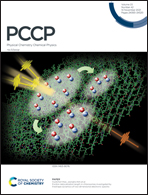Thermodynamics of adsorption of alcohol dehydrogenase on the gold nanoparticle surface: a model based analysis versus direct measurement†
Abstract
Characterization of the nanoparticle protein corona has gained tremendous importance lately. The parameters which quantitatively establish a specific nanoparticle–protein interaction need to be measured accurately since good quality data are necessary for the elucidation of the underlying mechanism and accurate molecular dynamics simulation. Here, we have employed surface sensitive second harmonic light scattering (SHLS) for investigating the adsorption of a tetrameric protein, alcohol dehydrogenase (ADH, Saccharomyces cerevisiae 147 kDa), on 16 nm, 27 nm, 41 nm, and 69 nm citrate capped gold nanoparticles (GNPs) in aqueous phosphate buffer at pH 7. We have extracted the binding constant, number of ADH bound per GNP, Gibbs free energy (ΔG°) from the decay of the second harmonic scattered signal as a function of protein concentration using a modified version of the Langmuir adsorption isotherm. The data obtained were checked with another technique, dynamic light scattering, using the same modified Langmuir model (MLM). While the binding constants measured by the two methods are in agreement, the number of ADH bound to each GNP obtained by the two methods varies a lot. In order to further probe this binding independent of a model fitting, we used an orthogonal fluorescence assay which measures the number of ADH bound to a GNP directly, and no model-fitting is necessary. We then used temperature dependent SHLS to measure the heat of adsorption (ΔH°) and entropy (ΔS°) for ADH–GNP corona formation. We found that the equilibrium binding constant (Kb) obtained from SHLS is of the order of 109 M−1 and the formation of the GNP–ADH corona is spontaneous with ΔG° ∼ −55 kJ mol−1. However, the adsorption is modestly endothermic, accompanied by a large increase in entropy. Stated differently, GNP–ADH corona formation is entropically driven. This is perhaps due to the tremendous disruption of the water structure at the negatively charged interface upon the arrival of the protein within the bonding distance to it. We believe that the SHLS technique is highly sensitive and reliable, at very low concentrations of both nanoparticles and proteins, for the quantitative estimation of the thermodynamic parameters of nanoparticle–protein corona formation, where many other techniques may fall short.



 Please wait while we load your content...
Please wait while we load your content...